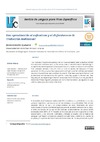Please use this identifier to cite or link to this item:
https://accedacris.ulpgc.es/handle/10553/70419
| Title: | Una aproximación al eufemismo y el disfemismo en la Traducción Audiovisual | Authors: | González Quevedo, Marta | UNESCO Clasification: | 570107 Lengua y literatura 550510 Filología |
Keywords: | Audiovisual translation Dubbing Subtitling Euphemism Dysphemism, et al |
Issue Date: | 2019 | Journal: | LFE. Revista de Lenguas para Fines Específicos | Abstract: | The processes of euphemism and dysphemism have not been studied in depth in the field
of Audiovisual Translation (AVT). In this article, a deductive data analysis methodology is
applied to the use of euphemism and dysphemism in six modern American science-fiction
films (released between 2009 and 2015) in order to identify the behaviour of these
processes. For this purpose, the original version in English and the subtitled and dubbed
versions in Spanish have been analysed. As a result, it has been possible to find out what
euphemisms and dysphemisms are used for, when they appear in the text and their
frequency of use depending on the AVT mode used. From this data, it will be possible to
determine if these linguistic processes are norms that translators use regularly to cope
with the audiovisual restrictions in the texts. En el ámbito de la Traducción Audiovisual (TAV), el eufemismo y el disfemismo son dos procesos lingüísticos que todavía no se han estudiado en profundidad. Este artículo pretende mostrar el uso y el comportamiento de estos fenómenos en textos audiovisuales utilizando una metodología que parte de un análisis deductivo de los datos, a través del estudio de su uso en seis películas estadounidenses de ciencia ficción estrenadas entre 2009 y 2015. Para ello, se han analizado la versión original de los filmes seleccionados y sus versiones subtitulada y doblada al español con el objetivo de averiguar qué función cumplen los procesos de eufemismo y disfemismo, cuándo se emplean y con qué frecuencia en función de la modalidad de TAV de que se trate. A partir de los datos, queremos determinar si, actualmente, estos procesos lingüísticos son normas empleadas por los traductores habitualmente para salvar las restricciones que imponen el medio y las modalidades de TAV. |
URI: | https://accedacris.ulpgc.es/handle/10553/70419 | ISSN: | 2340-8561 | DOI: | 10.20420/rlfe.2019.286 | Source: | Lfe-Revista De Lenguas Para Fines Especificos [ISSN 1133-1127],v. 25 (2), p. 58-74, (2019) |
| Appears in Collections: | Artículos |
WEB OF SCIENCETM
Citations
2
checked on Feb 25, 2024
Page view(s)
94
checked on Mar 9, 2024
Download(s)
129
checked on Mar 9, 2024
Google ScholarTM
Check
Altmetric
Share
Export metadata
Items in accedaCRIS are protected by copyright, with all rights reserved, unless otherwise indicated.
